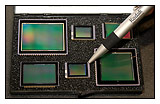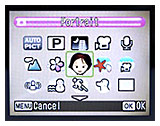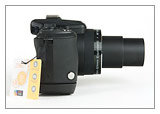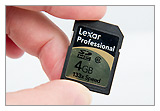Digital Camera Features
By now, you have determined your needs, goals and budget, and identified the type of camera you want. It’s time to learn to evaluate specific features so that you can home in on the camera that’s best for you.
Megapixels – This is the number of pixels on a camera’s sensor and determines a photograph’s
 resolution. One megapixel equals one million individual pixels. In theory, the bigger the number the better. But while megapixels used to be an important factor when comparing digital cameras, all cameras now have more than enough resolution for most people’s needs. For example, a 3MP camera provides plenty of resolution for viewing on a computer screen and 8MP is more than enough to make a 16×20 print. Ten-megapixel sensors are standard now and some cameras have 15 megapixels or more. Sounds great, until you consider how much space those files will take up on your memory card and computer hard drive. Unless you’re shooting for huge enlargements or publication, stick with a camera in the 8 to 12MP range.
resolution. One megapixel equals one million individual pixels. In theory, the bigger the number the better. But while megapixels used to be an important factor when comparing digital cameras, all cameras now have more than enough resolution for most people’s needs. For example, a 3MP camera provides plenty of resolution for viewing on a computer screen and 8MP is more than enough to make a 16×20 print. Ten-megapixel sensors are standard now and some cameras have 15 megapixels or more. Sounds great, until you consider how much space those files will take up on your memory card and computer hard drive. Unless you’re shooting for huge enlargements or publication, stick with a camera in the 8 to 12MP range.
Viewfinder and LCD – The viewfinder is what you look through to frame your subject. Not all point-and-shoots have real, optical viewfinders these days; many just rely on the LCD. This is fine for most people, unless you have a strong preference or shoot action, where a viewfinder can be helpful. The liquid crystal display on the back of the camera lets you frame your shot and review it afterwards, so it helps if the LCD is big, crisp, accurate and easy to see in bright sunlight. A tilt-swivel LCD can also be very useful for shooting from high and low angles (for example, concerts, self-portraits and flowers).
User Interface – The UI includes the various buttons and dials on the outside of the camera as well as the menus and settings inside. The menus and controls are often the most intimidating things about a camera, and some brands are more user-friendly than others. As you read reviews and examine models in the store, pay attention to how intuitive the controls and settings seem. Also take note of how the camera connects and uploads photos to your computer.
Exposure Modes – Nearly all cameras have some form of automatic exposure setting for those who want
 to let the camera do all the thinking. Many have an “intelligent” auto mode that can sense things like low light and close-up focus and adjust settings accordingly. Some cameras even have an “Easy” mode that turns off all but the most essential menus and settings. Most have a selection of user-friendly “picture” modes – presets ranging from Portrait to Landscape to Sports to Snow. If there is a certain type of subject you shoot a lot, look for a relevant picture mode. For example, if you often photograph your daughter’s dance performances, you might want to look for a “High Sensitivity,” “High ISO,” or maybe even “Concert” mode for taking pictures in dim lighting without flash. More ambitious photographers will want a camera with manual settings so they can take direct control of the shutter speed, aperture and sensitivity (ISO).
to let the camera do all the thinking. Many have an “intelligent” auto mode that can sense things like low light and close-up focus and adjust settings accordingly. Some cameras even have an “Easy” mode that turns off all but the most essential menus and settings. Most have a selection of user-friendly “picture” modes – presets ranging from Portrait to Landscape to Sports to Snow. If there is a certain type of subject you shoot a lot, look for a relevant picture mode. For example, if you often photograph your daughter’s dance performances, you might want to look for a “High Sensitivity,” “High ISO,” or maybe even “Concert” mode for taking pictures in dim lighting without flash. More ambitious photographers will want a camera with manual settings so they can take direct control of the shutter speed, aperture and sensitivity (ISO).
Image Stabilization – Mechanical image stabilization is such a great technological advancement that it’s hard to recommend buying a point-and-shoot without it. Image stabilization reduces blur from camera shake, especially in low-light situations. Different companies have different names for it; for example, Nikon calls it Vibration Reduction and Sony calls it Super Steady Shot. There are two types of image stabilization: mechanical, which moves the lens or sensor to compensate for camera shake, and digital, which boosts ISO for a faster shutter speed. Mechanical image stabilization is much better than digital, which results in noisy photos.
Image Stabilization Guide >>
Lens – Point-and-shoot and other compact digital cameras have built-in zoom lenses ranging in length
 from 3x to 26x, which, if they were 35mm lenses, would mean maximum focal lengths of approximately 114mm and 676mm. Anything over 10x is considered a “superzoom.” If you frequently shoot faraway things like football or wildlife, a long lens is desirable. But there is always a tradeoff between lens length, image quality and cost. You may also want to look for a wide-angle lens 28mm or wider, which will make it possible to capture more of a scene – such as group shots or tight quarters like a dorm room. Finally, don’t be fooled by the “digital zoom” sales pitch. Optical zoom (provided by the glass in the lens) is far superior to digital zoom (computerized magnification). Digital zoom quality is terrible and should be a last resort.
from 3x to 26x, which, if they were 35mm lenses, would mean maximum focal lengths of approximately 114mm and 676mm. Anything over 10x is considered a “superzoom.” If you frequently shoot faraway things like football or wildlife, a long lens is desirable. But there is always a tradeoff between lens length, image quality and cost. You may also want to look for a wide-angle lens 28mm or wider, which will make it possible to capture more of a scene – such as group shots or tight quarters like a dorm room. Finally, don’t be fooled by the “digital zoom” sales pitch. Optical zoom (provided by the glass in the lens) is far superior to digital zoom (computerized magnification). Digital zoom quality is terrible and should be a last resort.
Flash – Almost all digital cameras these days have a built-in flash. They are fine for party pictures and other close-range shots, but may have a slow recycle time and their positioning sometimes causes red-eye and bad shadows. Advanced photographers who want more powerful, controlled flash with little waiting time between shots will need an external flash (purchased separately) and a camera with a hot shoe flash mount.
Continuous Shooting and Bracketing – A friend once told me she wanted a camera that went “pew-pew-pew.” Imagine, if you will, the clicking sounds of a continuously shooting camera shutter. Many point-and-shoots and compacts do have one or more burst modes, along with auto-exposure-bracketing, which takes multiple exposures of each shot.
Self-Timer and Remote Control – These are handy for group shots, self-portraits and long exposures on a tripod. Most cameras have self-timers, but some have additional options, like a two-shot setting. Remote controls are less common, but are included with some cameras and as an available accessory for others.
 Memory Card – Digital photo files are stored on a memory card, which is usually purchased separately. Check your camera to see which type of memory it uses. The most common are SD (Secure Digital) cards, CompactFlash and Memory Stick. Capacity is always increasing; 1, 2 and 4 GB cards are typical now. It’s wise to buy the biggest you can afford, and if you travel, it’s nice to have two. If you are serious about video, make sure you buy a “fast” memory card that won’t choke when recording.
Memory Card – Digital photo files are stored on a memory card, which is usually purchased separately. Check your camera to see which type of memory it uses. The most common are SD (Secure Digital) cards, CompactFlash and Memory Stick. Capacity is always increasing; 1, 2 and 4 GB cards are typical now. It’s wise to buy the biggest you can afford, and if you travel, it’s nice to have two. If you are serious about video, make sure you buy a “fast” memory card that won’t choke when recording.
Digital Camera Memory Guide >>
Battery – Most digital cameras use either AA batteries or a proprietary lithium-ion battery. Both have pros and cons. Some people prefer AA batteries because they can be purchased almost anywhere; rechargeable AAs are also an option. But lithium-ion batteries are lighter and have a lot more capacity. A lithium-ion battery and charger is included with cameras that require them, but AAs may or may not be included. One of my pet peeves is lithium-ion chargers that have unwieldy cords; I’ve learned to look for cordless chargers that plug directly into the outlet. I also like to buy an extra lithium-ion battery for back-up.
Manual – Some cameras come with hardly any manual at all. Others come with thick, overwhelming manuals. Some are written in three languages at once; others may as well have been written in another language. Some manuals are concise and well-written. Some have a handy, searchable online version. If the manual is important to you (and it should be), check it out in advance.
next page – Conclusion >>
|



Just wanted to say that in the 15 minutes I have spent on this site I have learned alot more about cameras than I did spending 3 hrs on photo.net this morning. If you are looking to purchase a camera then this is the place to learn about cameras before you buy